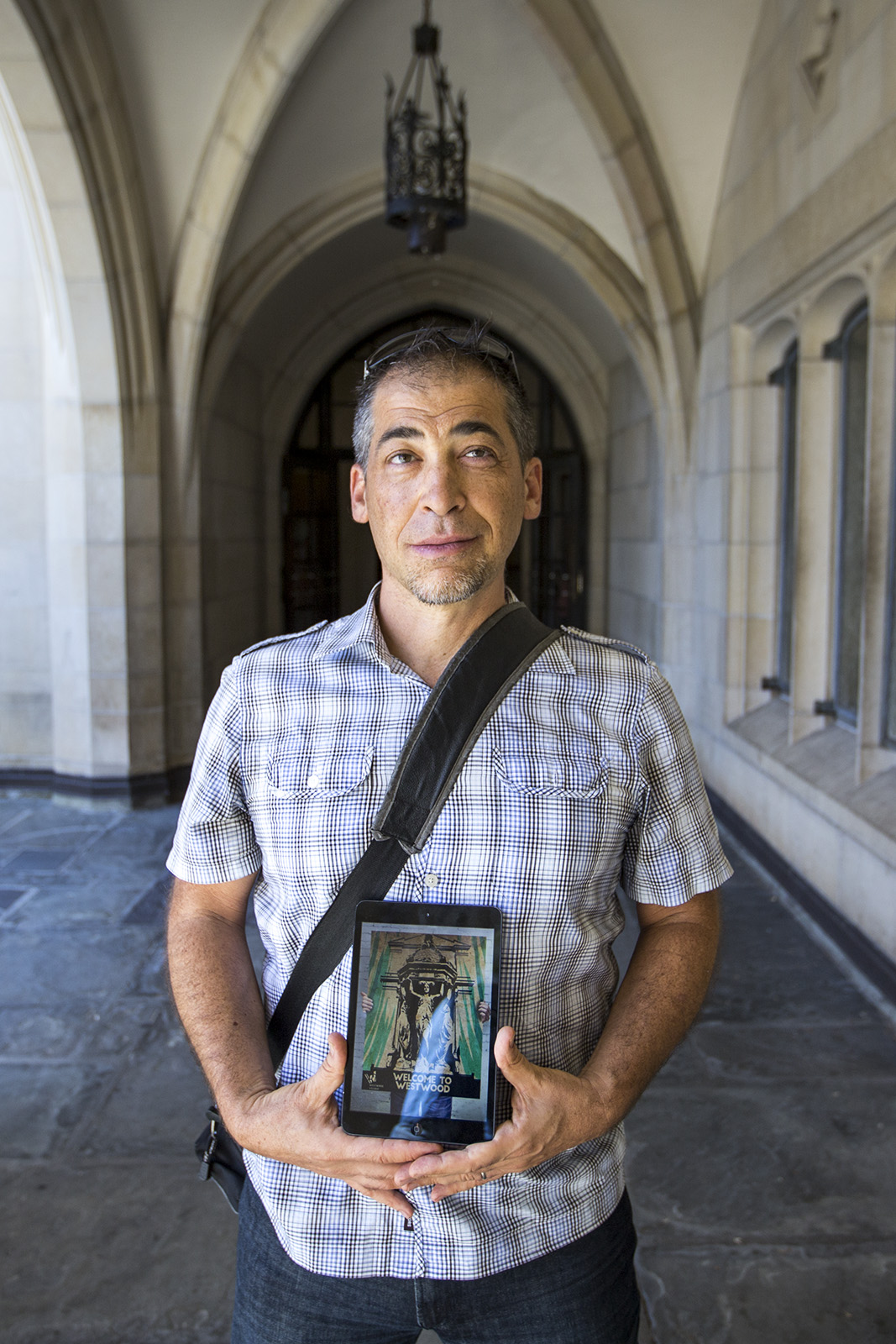Art instructor brings modern flair to historic Westwood landmarks

Eric Rosner, who teaches at UCLA Extension, was approved by the Westwood Village Improvement Association to decorate utility boxes around Westwood with stylized interpretations of Westwood buildings. (Keila Mayberry/Daily Bruin)
By Shreya Aiyar
Oct. 2, 2015 1:44 a.m.
Eric Rosner spent over 20 years sketching the grand, swooping skyline of New York City, where each tower and pointed spire felt like home.
When he moved to Westwood from New York City two years ago however, he felt the cultural shock. He said internalizing the history behind architecture in Los Angeles was difficult until he became used to the culture.
“Every city has a unique story, but I was ignorant of that when I came to Los Angeles,” said Rosner, a digital illustrator and UCLA Extension faculty member. “This city created a future out of nothing – I was amazed.”
On Sept. 17, the Westwood Village Improvement Association approved Rosner’s stylized interpretations of Westwood buildings to decorate the faces of city utility boxes. While the plan and its execution are still pending citywide approval, Rosner said he hopes his art will bring a modern flair to recognizable landmarks around Westwood.
Rosner’s artwork reimagines spots in Westwood with a pop-art twist. An image pitched to the council includes the Fox Theater’s neon spire outlined in monochromatic red and overlaid over a starry nighttime sky.

Rosner said Westwood Village was a perfect location for his artistic analysis of the landmarks because of its proximity to UCLA.
Because the town is central to student experiences, Rosner said students color the district’s culture. He added that Westwood challenged him to study notable student haunts, such as the Regency Village Theatre, and analyze landmarks that impact Westwood residents.
“Students are coming to college with aspirations and a need to know what’s going on in the world,” Rosner said. “We don’t have to just show the landmark for itself – we can show the dynamism of the architecture, what it means to people and where it’s going, the future of it.”
Rosner said Westwood was the community of the future and UCLA the center of progress in the 1920s and 1930s.
The beginnings of pop art in the 1970s, spurred by Andy Warhol’s works, created storylines that Rosner said were fascinating to include in his artwork.
“Changing times changed (the town) and made it go up and down, but I think Westwood’s going back up again,” Rosner said. “I was excited to recreate the glory of those days, the heyday of Westwood, but with a modern twist.”
Andrew Thomas, the executive director of the Westwood Village Improvement Association, said the most likely method of applying the art to the utility boxes is to print Rosner’s stylized digital interpretations of Westwood landmarks onto vinyl wraps that fit the boxes’ dimensions.
Vinyl decals, Thomas said, are relatively inexpensive and ensure the exact digital interpretation of the art. Many are graffiti-proof and easy to replace in case of damage.
Thomas said a major factor in choosing Rosner’s artwork to decorate Westwood was the branding potential.
Rosner’s designs, Thomas said, could potentially spark interest in passersby because of their bright colors and contemporary interpretations of recognizable landmarks.

Thomas said the alternative to using Rosner’s artwork was covering the boxes with the town’s Westwood Village “W” icon, which currently decorates the district’s letterhead, website, social media, app, certain storefronts and trashcans.
“We didn’t want to kill everybody with an overload of our logo,” Thomas said. “(The utility boxes) are ugly, but they’re also canvases waiting for the opportunity for us to display something fresh.”
Brian MacMahon, a prior commissioner of Rosner’s work, said Rosner is skilled at accentuating the aspects of each building in his art.
“A building is very seldom just a building. More often than not, it portrays what made it strong,” MacMahon said. “(Rosner will) take the attitude of the building, the attitude of the era, the attitude of why it was created, and … make a point.”
Rosner said one of the most fascinating parts of undertaking this project was experiencing the intersection of history and art firsthand in a new environment.
One of his goals, he said, is to emphasize his newfound personal appreciation of Westwood in his artwork to generate a sense of excitement about progress.
“You live in a house, and the walls are white. All of a sudden, you paint them blue,” Rosner said. “Changing what is old gets you excited for the same old thing – instead, we have to reinvent things, create the future.”


